Daihatsu Mira
Daihatsu Mira
From newnocar.blogspot.com, the free encyclopedia
| Daihatsu Mira | |
|---|---|
 | |
| Overview | |
| Manufacturer | Daihatsu |
| Also called | Daihatsu Cuore Daihatsu Domino Daihatsu Handivan Subaru Pleo (second generation) |
| Production | 1980–present |
| Body and chassis | |
| Class | Kei car or City car |
| Related | Daihatsu Leeza Daihatsu Move Daihatsu Opti Daihatsu Ceria Perodua Kancil Perodua Kelisa Perodua Viva Daihatsu Ayla |
| Chronology | |
| Predecessor | Daihatsu Max Cuore |
The Daihatsu Mira (also known as the Cuore, Domino, and more recently Charade), is a kei car-type vehicle built by the Japanese car maker Daihatsu. It comes with a variety of options and chassis variations, with the latest variant having four models: "Mira", "Mira AVY", "Mira Gino" and "Mira VAN". The Mira is the latest successor to the line of cars begun with the Daihatsu Fellow of 1966 and was originally introduced as the commercial version of the Cuore. Outside Japan, the Mira has also been offered with an 850 cc or 1000cc engine. In Australia, the two-seater version was marketed as the Daihatsu Handivan and later as the Daihatsu Handi.[1]The name "mira" is Latin meaning "goal" or "purpose."
Contents
[hide]History[edit]
The Daihatsu Mira and Cuore replaced the Daihatsu Max Cuore in July 1980. This was replaced by the second generation (L70) of the Mira/Cuore which was introduced in 1985. For most generations there were two engine sizes available: one smaller version, to suit Japanese domestic regulations, of either 550 or 660 cc, and a bigger-engined version for export markets. The L200 variant (1990–94), for instance, came with a three-cylinder 660 cc engine with 40–64 PS (29–47 kW) in Japan, while other parts of the world received a bigger-hearted variant with an 847 cc or 1000 cc. The L500 Mira is the first kei car from Daihatsu to offer a four-cylinder (660 cc) engine.
L55 series (1980)[edit]
| Daihatsu Mira L55/L60 | |
|---|---|
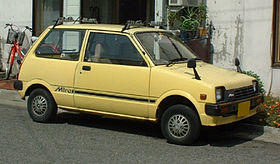 | |
| Overview | |
| Also called | Daihatsu Cuore Daihatsu Domino |
| Production | 1980.06–1985.08 |
| Assembly | Osaka, Japan |
| Body and chassis | |
| Body style | 3-door hatchback/van 5-door hatchback |
| Layout | Front engine, front-wheel drive / four-wheel drive |
| Powertrain | |
| Engine | 547 cc AB10/30/31 I2 547 cc AB35 turbo I2 617 cc AD I2 |
| Transmission | 4/5-speed manual 2-speed Daimatic 2-speed automatic |
In July 1980,[2] the Daihatsu Mira and Cuore arrived to replace the Daihatsu Max Cuore. A certain amount of confusion arises from the fact that this, the L55-series, was the first generation Daihatsu Mira but is usually considered the second generation of the Cuore – and that the Mira was originally marketed as the "Mira Cuore". The range was facelifted lightly in May 1982, when the Mira dropped the "Cuore" portion of its name. Also new was the sporty five-speed MGX (three doors only), fitted with radial tires. The autoclutch "Daimatic" transmission was replaced by a fully automatic two-speed unit at the same time. In October 1983, turbocharged and four-wheel drive versions of the Mira van were made available (not in conjunction, however).
The L55 series was sold with two main engines: the two-cylinder AB10 unit of 547 cc, and the slightly larger 617 cc AD unit which was installed in the export-only L60 Cuore.[3] They both featured twin balancing shafts, producing a smoothness and silent operations on par with a traditional four-cylinder engine. In tests, the 617 cc version of the car received plaudits for its refinement as well as its "lively" character and "enthusiastic" performance when compared to European competitors such as the Fiat Panda 30 and the Citroën Visa Club, both also with two-cylinder engines.[4] The main issue was cost: the balance-shaft equipped bicyclinder supposedly cost as much to build as a conventional four-cylinder engine. The car was also commended by Quattroruote for its agile city driving characteristics – although it could hardly be considered fully fit for the autostrada. The 30 PS (22 kW) "big" version has a top speed of 120 km/h (75 mph).[4]
The bigger engine was introduced in the second half of 1982, as part of a push by Daihatsu to push its European exports.[5]In some markets, the two engines were both available. In Belgium, for instance, they were sold as the Cuore 550 for the small version and as the Cuore 623/625, depending on which bodywork was fitted.[6] The Cuore sold well in both Argentina and Chile in 1980 (4,300 cars shipped), but economic hardship there led to a cancellation of exports by 1982.[5]
In 1983 the Mira Turbo appeared. Only available in the Japanese market, and only as a commercial vehicle, it had a carburetted and turbocharged version of the little two-cylinder engine. This was enough for 41 PS (30 kW) and a resulting top speed of 130 km/h (81 mph).[3]
Giovanni Michelotti used this generation Cuore as the basis for the "Michelotti PAC" prototype (Personal Automotive Commuter) shown at Geneva in 1985.[7]
L70 series (1985)[edit]
| Daihatsu Mira L70 | |
|---|---|

Very late (1990) second generation Mira "Parco"
| |
| Overview | |
| Also called | Daihatsu Cuore Daihatsu Domino Daihatsu Miracab Norkis Legacy (Philippines) |
| Production | 1985–1990 |
| Assembly | Osaka, Japan |
| Body and chassis | |
| Body style | 3-door hatchback/van 5-door hatchback/van 2-door pick up (Thailand, Phil.) |
| Layout | Front engine, front-wheel drive / four-wheel drive |
| Powertrain | |
| Engine | 547 cc EB I3 796 cc ED-10A I3 847 cc ED-10 I3 |
| Transmission | 4/5-speed manual 2-speed automatic |
The second generation (L70) Mira/Cuore appeared in August 1985. It had a longer wheelbase and a new generation of three-cylinder engines replacing the previous two-cylinder (AB) versions. Displacement of the new EB engines remained exactly the same, at 547 cc. For the export versions an 847 cc three-cylinder was developed, called ED-10. In September 1986 a special version for the Swiss market appeared, with a narrower bore version displacing 796 cc (called ED-10A). Unlike the fractionally larger standard version, this one suited the four tax horsepower category in certain cantons, while other cantons had prominent tax limits at 800 cc.[8]
As for the domestic Japanese market versions, there were commercial versions (Mira) sold alongside passenger car versions (Cuore). The commercials had temporary rear seats which fold completely flat, and are easily recognized by luggage rails in the rear side windows. As for the previous generation, a version with switchable four-wheel drive was available for the "Van" version (chassis code L71V). The engines were originally carburetted, and either naturally aspirated or turbocharged (with intercooler). These offered 38 PS (28 kW) and 52 PS (38 kW) respectively.[9] The turbo version was originally only available as a Mira (three-door commercial), and was introduced two months after the regular version. Transmissions were either four- or five-speed manuals, with a two-speed automatic also available for the atmospheric versions.[10]
In January 1986, a five-door "Van" (Mira) version was added. A "Walk-Through Van" version, using the regular bonnet combined with near square rear bodywork, appeared two months later. In August 1987, the Mira/Cuore received a minor facelift with a new grille and bonnet, as well as some other detail changes all making for a smoother appearance overall. Two months later a permanent four-wheel-drive version was made available in the turbocharged version. After having undergone another minor change in October 1988, a 50 PS turbocharged Mira Sedan TR/CR series for passenger use was also made available – as a five-door version as well. A limited edition of 500 Mira Sedan TR-XX Limited were also sold.[11]Japanese production of the L70 series ended when the new 660 cc L200 version was introduced in March 1990 in response to new regulations for the kei class.[10] This also marked the end of the division of the line into Mira and Cuore, as the Cuore nameplate was retired in Japan with the introduction of the new model.
Thailand[edit]
Daihatsu's Thai arm carried on producing the L70 series after it was replaced in Japan. In addition to the regular version, they also developed a ute version for the pickup-hungry Thai domestic market from 1990 to 1995, called Mira P1. This was built with a pickup bed, tail gate and redesigned taillights. The Mira pickup was extremely popular, with Daihatsu's Thai sales jumping by 50 percent as a result.[12]Coming full circle, and mirroring the development of the SUV, Daihatsu also developed the Mira P4: a roofed four-seater wagon version of this micro-ute. Some P4s retained the pickup's fold down tailgate, adding a top-hinged glass, while some had a top-hinged one-piece tailgate. Later, there was an extended cab 2+2-seater ute ("Daihatsu Miracab") and also a hatchback with an enlarged rear end, called the "Mint".
While originally using the smaller engines as per the Japanese market, these were too long to be classified as true kei cars. Later cars have the 850 cc engine as used in many other export markets.[13] Nonetheless, the 1997 Asian financial crisis marked the end for Daihatsu in Thailand as sales plummeted from 4,000 in 1995 to 160 in 1997. Production ended in February 1998 and by March 1998 Daihatsu no longer offered cars in the Thai market.[13]
Philippines[edit]
In 2004 a Philippine company revived the Mira Pickup, built locally and sold as the Norkis Legacy.[14] A panel van version is also available, as is a four-door double cab with a very short bed. Unlike the original L70 Mira, they have the later 659 cc EF engine which is also available to run on LPG. It is longer and heavier than the original, with the original two-seat pickup weighing in at 900 kg (1,984 lb) and 3,630 mm (143 in) long.
L200 series (1990)[edit]
| Daihatsu Mira L200 | |
|---|---|

Daihatsu Mira three-door, Australia
| |
| Overview | |
| Also called | Daihatsu Cuore Daihatsu Domino Daihatsu Handivan |
| Production | 1990–1994 |
| Assembly | Osaka, Japan |
| Body and chassis | |
| Body style | 3-door hatchback/van 5-door hatchback/van |
| Layout | Front engine, front-wheel drive / four-wheel drive |
| Related | Daihatsu Opti Perodua Kancil Daihatsu Ceria |
| Powertrain | |
| Engine | 547 cc EB I3 659 cc EF I3 847 cc ED10 I3 |
| Transmission | 4/5-speed manual 2/3/4-speed automatic |
The L200/201 was the third and thus far most popular generation of the vehicle, offered in a large number of variants. In the Japanese domestic market the "Cuore" name was dropped, as the differences between passenger and commercial versions were narrowed. The L200 (front-wheel drive) was produced with the Mira badge from the spring of 1990 until at least 1998, but the platform has lived on under other names. L201 was the chassis code used on export market cars, usually labelled "Cuore".
As with most Kei cars, the 200-series came in two primary variants: The "V" Series is a windowed van style intended for light commercial use. This variant featured a fold down rear bench seat without seat belts. The "S" series, intended for private use, is largely similar but the larger, more comfortable rear seats are equipped with belts and are further to the rear of the vehicle with more leg room. While the seats still fold down, unlike the "V", the "S" does not offer a flat loading floor. These characteristics are due to Japanese tax preferences for commercial vehicles, which only allow for temporary accommodation in the rear and demand a flat loading floor. The range received a very subtle facelift of a more rounded overall appearance for 1993, it included altered front and rear lights, bumpers, and a new bonnet and front seats.[15] This version was available to Japanese customers from August 1992 and also incorporated some changes to the lineup, including the new RV-4 model with crossover pretensions. Turbocharged automatics now received a four-speed transmission.
The Mira could either be equipped with a three-speed automatic, or four- or five-speed manual transmission. A four-wheel drive variant known as the L210 was also available in V or S models, only with the five-speed manual. An electronically fuel-injected 12-valve (four per cylinder) turbo was the range topper, whereas the normally aspirated base versions made do with a one barrel carburetor. There was also a version with mechanical four-wheel steering (L220), so far the only Kei car to feature this option.[16] To break the stranglehold of the Suzuki Alto Works on the All-Japan Rally Championship, the Mira X4R was developed in 1991. It had a strengthened engine with a forged crankshaft and flywheel and other detail improvements, a close-ratio gearbox and various chassis improvements. Equipment was stripped, with a minimal interior and diagonal tires since everything would be altered by competitors. The Group A X4R was sold at a rate of about ten units per month at a price about twenty percent higher than the regular X4. Noriyuki Hotta won the class championship in 1992.
A taller, highly customizable two-seat step-van variant ("Walk-Through Van") was also produced, solely for the Japanese market. This reached the maximum height allowed for kei cars, two metres.
- Export
The L201 was sold outside Japan primarily in Europe, Australia and New Zealand. The three or five-door 201 retained the larger displacement engine of 847 cc (ED10K) and a choice of four- or five-speed manual transmissions, or a three-speed automatic option. This carburetted engine produced 41 PS (30 kW) (ECE) at 5,500 rpm.[16] Van versions were also available in Australia, called Handivan (later shortened to Handi).[17] The Van, sometimes with filled in rear windows, was also marketed in certain other markets (such as the Benelux countries) where the tax structure favoured it.
The 200/201 had myriad market and model differences. Cuore badged L201's received a fog lamp on the left side. Later models of the Mira had fog lamps on both sides. The L201 had two license plate lamps while the L200 had only one. L200 Miras produced for Japan had no rear fog lamps, when sold in the United Kingdom (where Japan spec Miras were also available) they had a rear fog lamp mounted on the right hand side. Despite the Mira badge mostly being available in Right Hand Drive markets, left hand drive Mira-badged L201's were sold in the Dominican Republic.
This generation of the Mira was chosen by Malaysia's Perodua to be re-badged as its first product. The L200 went on sale in Malaysia as the Perodua Kancil in 1994. After several facelifts, production of the Kancil finally came to an end in July 2009. The Malaysian built Kancil was marketed as the Daihatsu Ceria in Indonesia between 2000 and 2006.
L500 series (1994)[edit]
| Daihatsu Mira L500 | |
|---|---|
 | |
| Overview | |
| Also called | Norkis Legacy (Phil.) Daihatsu Cuore |
| Production | 1994–1998 |
| Assembly | Osaka, Japan Karachi, Pakistan |
| Body and chassis | |
| Body style | 3-door hatchback/van 5-door hatchback/van |
| Layout | Front engine, front-wheel drive / four-wheel drive |
| Related | Daihatsu Move (L600) Daihatsu Opti |
| Powertrain | |
| Engine | 659 cc EF I3 659 cc JB I4 847 cc ED I3 |
| Transmission | 4/5-speed manual 3/4-speed automatic |
Production of the L500 Miras started in September 1994. The design of the car was slightly altered throughout but retained a look similar to that of the L200. The L500 Mira was badged outside Japan primarily as the L501 Cuore. The 200 series Mira ceased sales in Japan but continued in some other markets, where it received the same engine updates as did the export market L500.
In the Japanese market the "Mira Moderno", a separate range of cars (non-commercials) was added in October 1995. This range received a minor facelift in May 1996, which was extended to the rest of the range in May 1997. In August 1997 the Mira Classic was added, a retro-look version. The Classic was available with naturally aspirated engines (40 PS or 29 kW as a front-wheel drive, 55 PS or 40 kW with 4WD) or a turbocharged option with 64 PS (47 kW). The Classic was succeeded by the equally retro-designed Mira Gino which was based on the fifth generation (L700). In January 1998, in cooperation with Sanrio, a "Hello Kitty" version of the Mira Moderno appeared. This was available in pastel colors and received various Hello Kitty details throughout the car, such as a Hello Kitty ignition key.
The L500 was Daihatsu's first kei class vehicle to feature a four-cylinder engine, with the option of the new JB series engine. When equipped with this engine, the model code became L502. The range of models available in the 200 platform more or less carried over to the 500 series. One change was that the export versions received fuel injection as standard, which brought the output of the 847 cc engine up by one, to 42 PS (31 kW). This engine was called the ED-20. The four-speed manual was no longer available, but a four-speed automatic joined the existing three-speed version in the domestic Japanese market.[18] In November 1996 a twin-cam, 12-valve version of the 847 cc three-cylinder was also made available. This, the ED-DE, produced 50 PS (37 kW) at 5,500 rpm.
In Australia the L500 Mira was sold as the Daihatsu Charade Centro. The model production was closed in 1995 only in Pakistan, as the Daihatsu Cuore. The L500 was produced by Toyota Indus Motor Company between 2000 and 2012, with the 847 cc carburetor engine (ED-10) which has been used in export models since 1986.[19]
L700 series (1998)[edit]
| Daihatsu Mira L700 | |
|---|---|
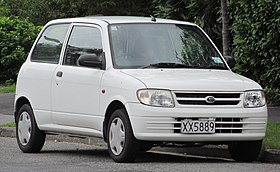 | |
| Overview | |
| Also called | Daihatsu Cuore |
| Production | 1998–2002 |
| Assembly | Osaka, Japan Serendah, Malaysia (as Kelisa) |
| Body and chassis | |
| Body style | 3/5-door hatchback/van |
| Layout | Front engine, front-wheel drive / four-wheel drive |
| Related | Daihatsu Move (L900) Daihatsu Mira Gino/Trevis Perodua Kelisa |
| Powertrain | |
| Engine | 659 cc EF I3 (L700/710) 847 cc ED-DE I3 989 cc EJ I3 (L701/711) |
| Transmission | 4/5-speed manual 3/4-speed automatic CVT |
The fifth generation Cuore received the chassis code L700, with L710 being used for four-wheel-drive versions. The new model appeared in the fall of 1998. While the engines of cars sold in the domestic Japanese market had to stay beneath the 660 cc threshold, export versions received a new larger engine: the 989 cc EJ-DE was a 12-valve DOHC three-cylinder, producing 56 PS (41 kW) at 5,200 rpm. Also new for export models was the availability of a three-speed automatic. After facelift on 2001 the car was equipment with new more powerful engine code EJ-VE engine with 58 PS (43 kW) and VVT-i.[20] For some markets the previous 850 cc ED-DE engine was retained.[citation needed]
Production elsewhere[edit]
Production of the L700 Mira was picked up in Malaysia in 2001, where it was sold alongside the Kancil as the Perodua Kelisa with the familiar Daihatsu E-series engines of 850 & 1,000 cc. Perodua ended production of the model in 2007.
Mira Gino[edit]
Main article: Daihatsu Mira Gino
A retro version of the Daihatsu Mira based on the L700 platform began production in 1999, replacing the preceding Mira Classic. The Mira Gino received features and options similar to those of the regular variant but was styled with a retro look. The Mira Gino was originally only offered with a 659 cc engine in Japan, but the 1-litre EJ-VE engine (as for the export market L700s) was briefly available in Japan as the Mira Gino 1000. A car based on the second generation Gino (which received its own modelcode of L650/L660) with a one-litre engine was sold as the Daihatsu Trevis in export markets.
L250 series (2002)[edit]
| Daihatsu Mira (L250/L260) | |
|---|---|

Daihatsu Mira Avy
| |
| Overview | |
| Also called | Daihatsu Charade Daihatsu Cuore |
| Production | 2002–2006 |
| Assembly | Japan: Osaka Malaysia |
| Body and chassis | |
| Body style | 3-door hatchback/van 5-door hatchback/van |
| Layout | Front engine, front-wheel drive / four-wheel drive |
| Related | Daihatsu Move Perodua Viva |
| Powertrain | |
| Engine | 659 cc EF I3 989 cc EJ I3 |
| Transmission | 5-speed manual 3/4-speed automatic or CVT |
| Dimensions | |
| Wheelbase | 2,390 mm (94.1 in) |
| Length | 3,395 mm (133.7 in) |
| Width | 1,475 mm (58.1 in) |
| Height | 1,500 mm (59.1 in) |
The L250/260 Mira, unrelated to the earlier 200-series, is the sixth generation of the car. The car is produced as the Mira in Japan. The L250 was labeled Daihatsu Charade in the United Kingdom and South Africa. Elsewhere this was badged and sold as the Cuore. Export versions, equipped with the 1-liter EJ engine as first seen in the previous generation, are L251, while L260 is used on four-wheel-drive versions (for the Japanese domestic market only). After the sixth Mira was replaced in late 2006, the production line was shifted to Malaysia, where production of this car as the Perodua Viva commenced in May 2007.
In Japan there is also a sportier Mira Avy version available. The range underwent a very minor facelift in August 2005. A special handicap friendly (Mira Friend-Matic) version appeared in November 2006. This car could be driven directly from a special self-powered wheelchair (the "Mira Self-Matic"), with a drivers door that could open at 90 degrees and a fully automated entry and exit system. Buyers of the Self-Matic would receive government assistance. The Friend-Matic version continued to be produced until August 2009.
L275 series (2006)[edit]
| Daihatsu Mira L275/L285 | |
|---|---|
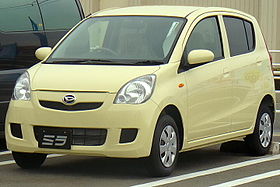 | |
| Overview | |
| Also called | Daihatsu Charade Daihatsu Cuore |
| Production | 2006–present |
| Assembly | Japan: Osaka |
| Body and chassis | |
| Body style | 3-door hatchback/van 5-door hatchback |
| Layout | Front engine, front-wheel drive / four-wheel drive |
| Powertrain | |
| Engine | 658 cc KF I3 996 cc 1KR-FE I3 |
| Transmission | 5-speed manual 3-speed automatic CVT |
| Dimensions | |
| Wheelbase | 2,490 mm (98.0 in) |
| Length | 3,395 mm (133.7 in) |
| Width | 1,475 mm (58.1 in) |
| Height | 1,540 mm (60.6 in) |
In December 2006 the L275, the seventh generation Mira, was presented. Initially only available as a passenger version, the Van derivative appeared in early 2007. As usual four-wheel-drive versions received a different model code (L285). Two 'Topaz Neo' KF engines are available: a 658 cc KF-VE twin-cam DVVT three-cylinder engine of 43 kilowatts (58 hp), and the KF-DET turbo engine of same displacement that produces 47 kilowatts (63 hp). The naturally aspirated engine is available with five-speed manual transmission, three- or four-speed automative transmission or continuously variable transmission.[21] Export models (L276) first appeared in September 2007 and receive the very light Toyota KR engine, an inline-three of one liter's displacement.
Under Japanese 10–15 test cycle, fuel economy varies from 21 km/L (59 mpg‑imp; 49 mpg‑US) for three-speed automatic transmission to 25.5 km/L (72 mpg‑imp; 60 mpg‑US) for continuously variable transmission. For cars with "Smart Drive package", which come with a new idle stop system, fuel economy increases to 27 km/L (76 mpg‑imp; 64 mpg‑US).[21]
Inside, the gear shift has been moved from between the front seats to centre dash.[22] There is an optional sliding rear seat, with a range of 255 mm, for more luggage room or extra kneeroom.[21]




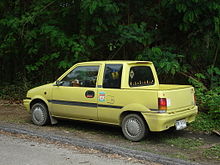





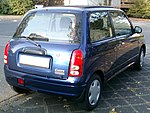
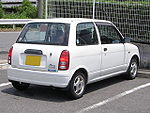



0 Comments:
Post a Comment
Subscribe to Post Comments [Atom]
<< Home